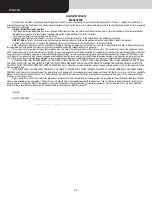
Cleaning Your Garage Door
IMPORTANT:
DO NOT USE A PRESSURE WASHER ON YOUR GARAGE DOOR!
While factory-applied finishes on garage doors are durable, it is desirable to clean them on
a routine basis. Some discoloration of the finish may occur when a door has been exposed
to dirt-laden atmosphere for a period of time. Slight chalking may also occur as a result of
direct exposure to sunlight.
Cleaning the door will generally restore the appearance of the finish. To maintain an aestheti-
cally pleasing finish of the garage door, a periodic washing of the garage door is recom-
mended.
THE FOLLOWING CLEANING SOLUTION IS RECOMMENDED:
A mild detergent solution consisting of one cup detergent (with less than 0.5% phosphate)
dissolved into five gallons of warm water will aid in the removal of most dirt.
NOTE:
The use of detergents containing greater than 0.5% phosphate is not recommended
for use in general cleaning of garage doors.
NOTE:
Be sure to clean behind weatherstrips on both sides and top of door.
CAUTION:
NEVER MIX CLEANSERS OR DETERGENTS WITH BLEACH.
GLASS CLEANING INSTRUCTIONS
Clean with a mild detergent solution (same as above) and a soft cloth. After cleaning, rinse
thoroughly.
ACRYLIC CLEANING INSTRUCTIONS
Clean acrylic glazing with nonabrasive soap or detergent and plenty of water. Use your bare
hands to feel and dislodge any caked on particles. A soft, grit-free cloth, sponge or chamois
may be used to wipe the surface. Do not use hard or rough cloths that will scratch the acrylic
glazing. Dry glazing with a clean damp chamois.
NOTE:
Do not use any window cleaning fluids, scouring compounds, gritty cloths or solvent-
based cleaners of any kind.
Painting Your Garage Door
Painting Instructions For Steel and Wood Doors.
Steel (Surface Preparation for Painting)
Wax on the surface must be removed or paint peeling/flaking will result. To remove this wax,
it will be necessary to lightly scuff the surface with a fine steel wool pad, saturated with
soapy water. A final wipe and rinse should be done with clean water only, to remove any
loose particles and any soapy film residue.
Surface scratches, which have not exposed the metal substrate, can be lightly buffed or
sanded with 0000 steel wool or No. 400 sand paper to create a smoother surface. Care must
be taken to not expose the substrate under the paint. Once the substrate is exposed, the
likelihood for rusting is greatly increased.
If substrate is exposed, it must be treated to prevent rust from forming. Sand the exposed
area lightly and paint with a high quality metal primer, specifically intended for galvanized
surfaces, to protect the area from corrosion. Follow the drying time on primer can label
before applying topcoat. The surface of the factory-applied finish, that is being painted, must
not be too smooth, or the paint will not adhere to it. It is advisable to test in an inconspicuous
area, to evaluate adhesion. If poor adhesion is observed, surface preparation for painting the
factory-applied finish, must be repeated until desired results are achieved. Again, care must
be taken to not expose the substrate under the paint.
Steel (Painting)
After surface has been properly prepared, it must be allowed to dry thoroughly, then coated
immediately with a premium quality latex house paint. Follow paint label directions explicitly.
Oil base or solvent base paints are not recommended. Please note that if substrate is
exposed and not properly primed, painting with latex paint may cause accelerated rusting of
the steel in the exposed area.
NOTES:
1. Repainting of finish painted steel doors cannot be warranted, as this condition is totally
beyond the door manufacturer’s control.
2. Consult a professional coatings contractor if in doubt about any of the above directions.
3. Follow directions explicitly on the paint container labels for proper applications of coatings
and disposal of containers. Pay particular attention to acceptable weather and temperature
conditions in which to paint.
Wood (Preparation and Painting)
These instructions apply to all Wood Doors produced and sold by Wayne Dalton. The exterior
surfaces, as well as all edges must be properly painted and maintained if satisfactory
performance is to be achieved. The purpose for painting is to both protect and beautify
the substrates. These requirements for finishing are intended to achieve both functions for
reasonable service life of wood doors. Wood doors must be completely finished prior to
installation, to ensure that the interior and exterior surfaces, as well as all edges of the doors
are properly protected against moisture or other contaminants. Wood doors, in a non-finished
condition, must not be transported or stored where the wood surfaces can be exposed to
moisture or other contaminants.
Wood (Surface Preparation)
All surfaces must be clean, free of dust and dirt and any other contamination.
Wood (Painting)
Using painter’s tape, tape off all metal surfaces. A premium quality latex house based finish
paint is recommended for use over the factory latex based primer
Painting the wood surfaces with at least 2 coats of finish paint over the primer. Follow paint
manufacture’s label directions completely for all coatings. Once finished, remove painter’s
tape and touch up where necessary.
Wood (Maintenance and Refinishing)
Yearly inspection of all the wood surfaces of the garage door(s) will reveal the extent of
weathering and the need for refinishing. When the finish becomes eroded or thin, clean
and prime the areas of deterioration. Follow up with a complete refinishing of the door(s),
according to the above directions, as well as the manufacturer’s label directions. Protecting
the door(s) from prolonged exposure to moisture and sunlight is vital in extending the service
life of your garage door(s).
Operation And Maintenance
OPERATING YOUR GARAGE DOOR…
Before you begin, read all warning labels affixed to the door and the installation instructions
and owner’s manual. When correctly installed, your Wayne-Dalton door will operate smoothly.
Always operate your door with controlled movements. Do not slam your door or throw your
door into the open position, this may cause damage to the door or its components. If your
door has an electric opener, refer to the owner’s manual to disconnect the opener before
performing manual door operation below.
Manual door operation:
For additional information on manual garage door operations go to
www.dasma.com
and
reference TDS 165.
IMPORTANT:
DO NOT PLACE FINGERS OR HANDS INTO SECTION JOINTS WHEN OPENING
AND/OR CLOSING A DOOR. ALWAYS USE LIFT HANDLES / SUITABLE GRIPPING POINTS
WHEN OPERATING THE DOOR MANUALLY.
Opening a Door: Make sure the lock(s) are in the unlocked position. Lift the door by using the
lift handles / suitable gripping points only. Door should open with little resistance.
Closing a Door: From inside the garage, pull door downward using lift handles / gripping point
only or a high friction area only. If you are unable to reach the lift handles/ suitable gripping
points only, use pull down rope affixed to the side of door. Door should close completely with
little resistance.
Using an electric operator:
IMPORTANT:
PULL DOWN ROPES MUST BE REMOVED AND LOCKS MUST BE REMOVED OR
MADE INOPERATIVE IN THE UNLOCKED POSITION.
When connecting a drawbar (trolley type) garage door operator to this door, an drawbar
operator and or drawbar operator bracket must be securely attached to the top section of
the door, along with any struts provided with the door. Always use the drawbar operator and
or drawbar operator bracket supplied with the door. To avoid possible damage to your door,
Wayne-Dalton recommends reinforcing the top section on models 8000, 8100, 8200 and
9100 doors with a strut (may or may not be supplied). The installation of the drawbar opera-
tor must be according to manufacturer’s instructions and force settings must be adjusted
properly. Refer to the owner’s manual supplied with your drawbar operator for complete
details on installation, operation, maintenance and testing of the operator.
MAINTAINING YOUR GARAGE DOOR…
Before you begin, read all warning labels affixed to the door and the installation instruc-
tions and owner’s manual. Perform routine maintenance steps once a month, and have the
door professionally inspected once a year. Review your Installation Instructions and Owner’s
Manual for the garage door. These instructions are available at no charge from Wayne-Dalton,
A Division Of Overhead Door Corporation, P.O. Box 67, Mt. Hope, OH., 44660, or at
www.
wayne-dalton.com
. For additional information on garage door/operator maintenance go to
www.dasma.com
and reference TDS 151, 167 and 179.
Monthly Inspections:
1. Visual Inspection:
Closely inspect jambs, header and mounting surface. Any wood found
not to be structurally sound must be replaced. Inspect the springs, counterbalance lift cables,
track rollers, pulleys, rear back hangs and other door hardware for signs of worn or broken
parts. Tighten any loose screws and/or bolts. Check exterior surface of the door sections
for any minor cracks. Verify door has not shifted right or left in the opening. If you suspect
problems, have a trained door system technician make the repairs.
18
Maintenance
Summary of Contents for TorqueMaster Plus 6100
Page 21: ......





































